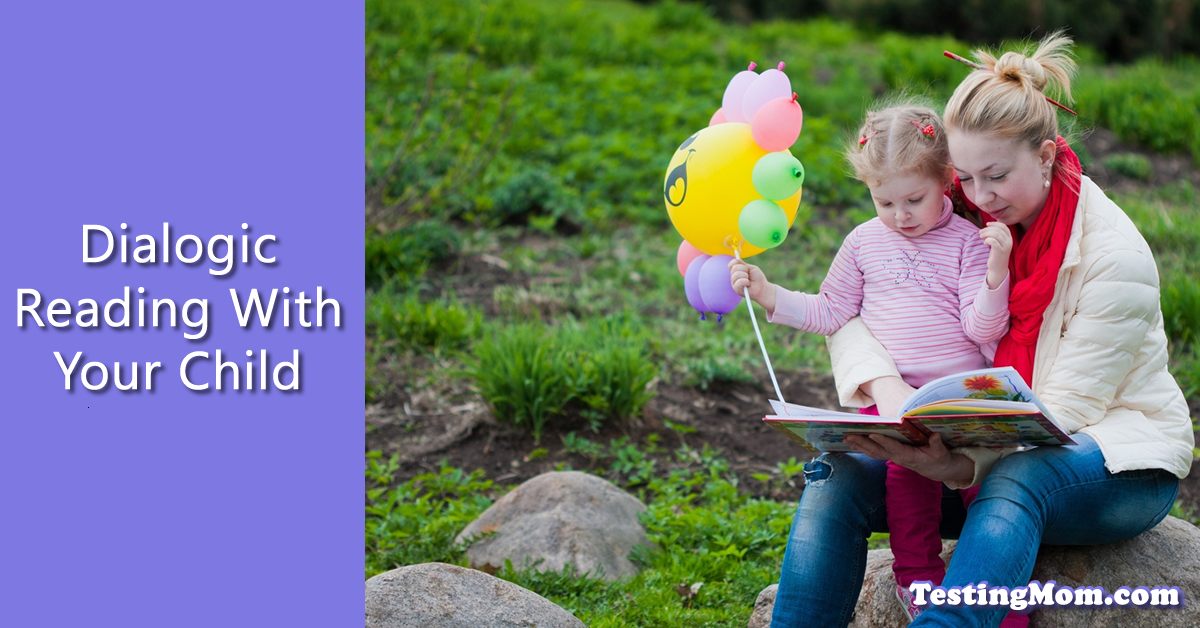› The Value of Dialogic Reading With Your Child
The Value of Dialogic Reading With Your Child
posted by Karen Quinn, The Testing Mom - May 17th, 2016
What is Dialogic Reading?
Dialogic reading (a technique developed by Dr. Grover J. Whitehurst) is a method where you not only read aloud to your child, but you also carry on a conversation about the book as you’re reading. So, gently guide your child through questions and expansions on what he or she says while paying attention to what most interests your child and his or her ability to answer questions (but without adding pressure or turning reading into a test).
How to Apply the PEER Method
So every page or two, you’ll initiate the PEER (Prompt, Evaluate, Expand, Repeat) sequence. This means that first you’ll Prompt your child to say something about the book. For small children, you might ask a “who, what or where” question, such as “His legs are short, but his tongue is __________?” or ask your child to point to things on the page.
Prompt
For children four to five years old, Prompts could include:
- A “when or why” question, such as: “Why did the frog hop away?”
- An open-ended question about something in the story, like: “What else do you see in the picture?”
- Connecting something in your own child’s life to the story, such as: “Remember when we went to the forest? What did we see?”
- In the middle of the story, ask your child what he or she thinks will happen next.
- Ask math or spatial questions about the book’s pictures, like: “How many frogs are in the puddle?” or “Which one is the biggest/smallest of them all?”
- At the end of the book, ask your child to summarize it in his or her own words.
Whenever you’re adding this technique into reading time, try to focus these Prompts on whatever things in the book your child already likes best.
Evaluate
Next in the PEER sequence of dialogic reading, you’ll Evaluate your child’s response. If your child gets the answer correct, praise and encourage him or her by saying something like, “That’s right, that is a giant frog!” But if your child is wrong, you can gently correct him or her without pointing out the mistake. For example: “That does look like a giant frog, but what about this one?”
Expand
Next, Expand upon what your child states by rephrasing or adding information, like: “Yes, that IS a giant frog. He’s called a Goliath frog.”
Repeat
Then, Repeat the original prompt in a way that incorporates the expansion, such as: “Can you say Goliath frog?”
How Effective is Dialogic Reading?
Here’s how dialogic reading actually works. Dr. Whitehurst studied the effectiveness of his technique by dividing children with comparable language skills into two groups: a control group whose mothers read to their children daily, and a treatment group whose mothers were trained in dialogic reading and used it daily with their kids. After four weeks, the treatment group scored 6.5 to 8 months ahead of the control group on two measures of expressive language in an IQ test. And they scored marginally ahead of the control group on measures of receptive language!
Add in Non-Fiction Reading, as Well!
Once you’ve mastered this technique with your own child, add some nonfiction books if your kid’s over the age of 5. Why? Because these books offer a higher-level vocabulary and “invisible connections” between sentences requiring coherence skills (the ability to infer missing information or hidden logic connecting sentences). Nonfiction books also allow children to practice recognizing implicit meanings within text. Dr. Marion Blank, a leading expert from Columbia University, explains: “If parents begin at about five years old to introduce interesting expository text into their bedtime reading, they will be doing something of enormous value for their [children’s] school success.” Books such as Amelia Lost: The Life and Disappearance of Amelia Earhart, The Boy Who Invented TV: The Story of Philo Farnsworth, and Hanging Off Jefferson’s Nose: Growing up on Mount Rushmore are some fun examples that kids love! Also, try to read nonfiction books that are related to your child’s life. If you’re going to visit the planetarium soon, choose a book about space. Just find a topic your child is interested in and let the magic happen!




Tell us about your experiences